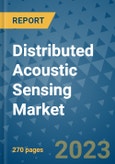The global distributed acoustic sensing (DAS) market is poised for extraordinary expansion, with a valuation of US$ 799 million in 2024, projected to soar to an impressive US$ 2000 million by the end of 2031.
In DAS systems, a laser transmits light through an optical fiber. Small variations in the fiber caused by changes in the surrounding environment, such as air movement or structural vibrations, reflect the light back to the source. The reflected light is then detected and analyzed to extract valuable information about the environment.
The growing adoption of Internet of Things (IoT) technology in the US fuels the demand for DAS systems. Increased use of connected devices across various industries is boosting the need for DAS systems.
This product will be delivered within 1-3 business days.
Revolutionizing Sensing Technology with DAS
Distributed Acoustic Sensing (DAS) is a groundbreaking technology that leverages a single optical fiber as a sensor to detect and analyze acoustic signals along its entire length. This passive, non-intrusive, and highly accurate method enables the monitoring and measurement of a wide range of physical phenomena, including sound, vibration, and temperature.In DAS systems, a laser transmits light through an optical fiber. Small variations in the fiber caused by changes in the surrounding environment, such as air movement or structural vibrations, reflect the light back to the source. The reflected light is then detected and analyzed to extract valuable information about the environment.
Driving Factors for the Distributed Acoustic Sensing Market
The surging adoption of DAS in seismology is a primary driver propelling the demand for distributed strain measurements across sectors such as aeronautics and civil engineering. Next-generation seismic networks heavily rely on advanced DAS technology for enhanced data acquisition, promising remarkable growth in the forecasted period.Challenges Faced by the Distributed Acoustic Sensing Market
While DAS technology holds immense promise, certain challenges hinder its widespread adoption:
- High Initial Investment: The installation and maintenance of DAS systems can be relatively costly, posing a significant barrier to entry for new companies and organizations. This initial investment may limit the adoption of DAS systems in cost-sensitive markets.
- Limited Technical Expertise: DAS systems are complex to install and operate, demanding specialized skills and training. The scarcity of technical expertise may restrict the adoption of DAS systems in certain markets.
US Market: Government Initiatives and IoT Adoption Drive Growth
In the United States, government initiatives are spearheading the adoption of advanced technologies like DAS. The US Department of Energy's investments in DAS research and development are expected to drive market growth.The growing adoption of Internet of Things (IoT) technology in the US fuels the demand for DAS systems. Increased use of connected devices across various industries is boosting the need for DAS systems.
Asia's High Global CAGR: India Takes the Lead
India emerges as a frontrunner in Asia, boasting a high global compound annual growth rate (CAGR) for the distributed acoustic sensing (DAS) market. While in its early stages, the Indian DAS market is poised for substantial growth. The commercial and industrial sectors drive DAS adoption in India, with large enterprises seeking energy cost reduction and sustainability improvements. As awareness of smart home devices and solutions grows, the residential sector is expected to follow suit.Europe's Flagbearer: Germany
Germany leads the DAS market in Europe with a well-established and growing presence. The country's strong focus on renewable energy integration underscores the importance of DAS in grid management, especially in handling the variability of renewable energy sources. In Germany, the commercial and industrial sector spearheads DAS adoption, with many large companies actively participating in DAS programs to adjust energy consumption based on electricity price fluctuations.Key Players Shaping the Distributed Acoustic Sensing Market
Leading companies at the forefront of the distributed acoustic sensing (DAS) market include:
- Halliburton Co.
- Schlumberger Limited
- Optasense
- Future Fibre Technologies
- Fotech Solutions Ltd.
- Silixa Ltd
- Bandweaver
- Omnisens SA
- HiFi Engineering Inc.
- Baker Hughes Incorporated
Key Segments of Distributed Acoustic Sensing Market Research
By Component:
- DAS Interrogator Units
- Visualization Software
- Service
- Deployment
- Maintenance
By Application:
- Oilfields
- Pipeline Management
- Security & Surveillance
- Transportation
By Region:
- North America
- Latin America
- Europe
- East Asia
- South Asia & Pacific
- Middle East and Africa (MEA)
This product will be delivered within 1-3 business days.
Table of Contents
1. Executive Summary
2. Market Overview
3. Production Output and Trade Statistics, 2018-2023
4. Price Trend Analysis, 2018 - 2031
5. Global Distributed Acoustic Sensing Market Outlook, 2018 - 2031
6. North America Distributed Acoustic Sensing Market Outlook, 2018 - 2031
7. Europe Distributed Acoustic Sensing Market Outlook, 2018 - 2031
8. Asia Pacific Distributed Acoustic Sensing Market Outlook, 2018 - 2031
9. Latin America Distributed Acoustic Sensing Market Outlook, 2018 - 2031
10. Middle East & Africa Distributed Acoustic Sensing Market Outlook, 2018 - 2031
11. Competitive Landscape
12. Appendix
Companies Mentioned
- Halliburton Co.
- Schlumberger Limited
- Optasense
- Future Fibre Technologies
- Fotech Solutions Ltd.
- Silixa Ltd
- Bandweaver
- Omnisens SA
- HiFi Engineering Inc.
- Baker Hughes Incorporated
Methodology

LOADING...








